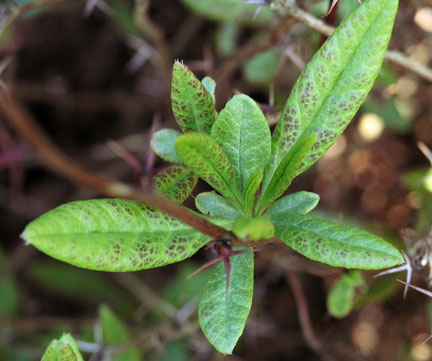
Woody > Berberis > Berberis sieboldii > Berberis sieboldii
Berberis sieboldii
Red-stemmed Barberry
Origin: Japan
| Family |
| Berberidaceae |
| Genus |
| Berberis |
| Species |
| sieboldii |
| Category |
| Woody |
| Type |
| Shrub (deciduous) |
| Pronunciation |
| USDA Hardiness Zone |
| 5 |
| Canadian Hardiness Zone |
| 4 - 6a |
| RHS Hardiness Zone |
| H7 |
| Temperature (°C) |
| -29 - (-23) |
| Temperature (°F) |
| -20 - (-10) |
| Height |
| 1 m |
Photographs
Description and Growing Information
Flowering Period
| Landscape |
| Works well in gardens and as borders and groundcover. |
| Cultivation |
| Will thrive in any soil type that is not waterlogged, and should be grown in full sun. |
| Growth |
| Medium |
| Pests |
| The bacteria Pseudomonas berberidis may cause black spots on leaves, and the berberry aphid (Liosomaphis berberidis) may also be a problem. |
| Bark/Stem Description |
| Stems are glossy and somewhat angular. |
| Leaf Description |
| Leaves are red when young, later becoming bright green above and paler beneath, growing to 7 x 2.5 cm. |
| Flower Description |
| Flowers to 6 in umbellate racemes that grow to 3 cm long. |
| Fruit Description |
| Fruit is a dark, shining red. |
| Propagation |
| Propagate by seed (although offspring may be variable), or by cuttings. |

.jpg)